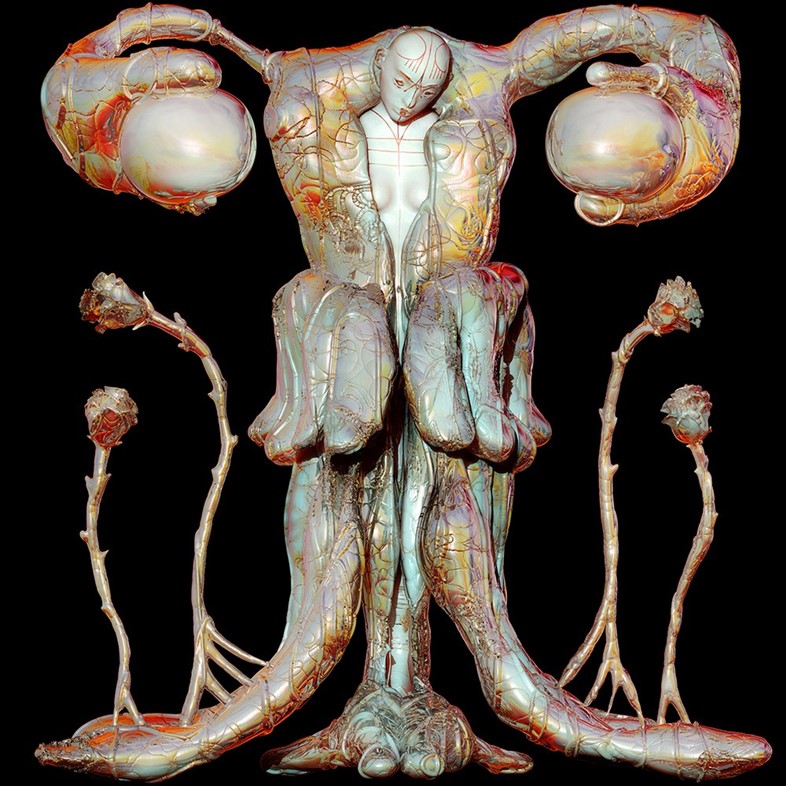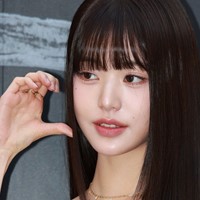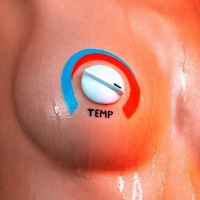We catch up with the artist and musician about his distinct approach to beauty
Perhaps you’ve seen Jesse Kanda’s visceral gothic surrealist art for iconic artists like Björk, FKA twigs, and Arca. His work often includes otherworldly 3D animations in the form of photo and video that twist and contort into deformed shapes. “The inside of our body is much more beautiful than the skin that coats it, yet we’re afraid of it. When you see blood or organs, you sense pain and danger,” Kanda said in his 2016 Dazed 100 interview.
When you see Kanda’s art you can’t help but think about his perception of beauty, it’s a spectrum of emotion often metamorphosed pain into beauty. The Japanese-born, Canadian raised self-taught artist combines his unfamiliarities and influences into his art while unafraid of exploring new avenues. While he’s widely known for his visual art, he also detours into music a passion that he’s always had – creating his 13-track debut album accompanied with 10 original artworks. Here, Doon Kanda presents: Labyrinth.
“My biggest fear that has informed a lot of who I am, that I’m constantly working on, is not being understood; which is also loneliness – the sense of not belonging,” he writes to me over email from Tokyo, where he is currently based. We discuss unfamiliarity and how these instances of whether it’s within an environment or identity impact creativity. It seems as though Kanda is dreaming up different worlds constantly making space for himself when the world often tries to put you in boxes. “Making a world that I belong in, that couldn’t be taken away from me, was appealing to me,” he muses. In honour of today’s (November 29) release of Labyrinth, we thought it was time to find out what is beautiful to Jesse Kanda, what the process is like for a person with a distinct approach to beauty, and how this has translated into music.
Growing up, what informed your understanding of beauty and identity and the way you presented yourself visually?
Jesse Kanda: The biggest influence was growing up in Japan – in contemporary society it’s manga, anime, and video games – and all of this lies on the shoulders of a hugely rich tradition of ‘bi’ (beauty) and the effort toward it. Artists like Hayao Miyazaki, Yoshitaka Amano, Matsumoto Taiyo, Yuasa Masaaki, Takeshi Kitano, Hosoe Eikoh, Tatsumi Hijikata, Kazuo Ohno, Hideaki Anno, Kurosawa Akira, I mean the list is countless… but these are some of the artists that have moved me since young and I hope my work kind of somehow fits in this sort of lineage. If they make up a tree, I’m a little young branch on the tip.
How does your environment impact your creativity? Does loneliness and being unfamiliar affect your creative state if you ever are either of these things?
Jesse Kanda: My biggest fear that has informed a lot of who I am, that I’m constantly working on, is not being understood; which is also loneliness – the sense of not belonging. I think this is common among those of us who are mixed-raced, multi-cultured, etc. It’s partly why I gravitated toward the fantasy worlds in art, video games, music, film and so on. I was so moved and really looked up to the people who made them. Making a world that I belong in, that couldn’t be taken away from me, was appealing to me.
How has the transition into music been? Did you always know you wanted to eventually? What pushed you to create Labyrinth?
Jesse Kanda: I always made music, I just didn’t do it as frequently as my visual work. But I always loved to. Like with anything you just gain confidence over time – doing it over and over and over. What pushes me is like an existential fear – death, and what pulls me is the hope I make something that gives me ecstasy – aliveness. Labyrinth just happened, like everything else I ever did. But, not without discipline and hard work of course. It’s a series of truth in each moment – not a premeditated and executed plan. Like when you have a dream, you wake up and interpret it. I write a song or make any work and do the same thing.
What’s your ideal recording situation?
Jesse Kanda: I exhaust my body preferably in nature for at least an hour, eat, bathe and I’m good to go! Hopefully a beautiful place I feel comfortable in and peace of mind.
The album is quite like a story, can you explain the sort of narrative it follows? Was it from a certain stage in your life that had a climax and ending to a certain situation?
Jesse Kanda: It has a lot to do with loss. But also it uses that to dive further into the depths of who I am. It might sound selfish, but I believe that the more personal a work, the more universal - because we are all connected in the deepest depths of us. It’s a comforting mantra at least, for someone like me. The track order has this arc that goes from hell to heaven. But each track also is its own microcosm in that the chaotic songs are still some transmutation into beauty – not just an expression of pain or anger.
How do you overcome a creative block?
Jesse Kanda: A creative block is just fear getting in the way. Identifying it as a block doesn’t help, because then you’re visualising some scary wall and making it worse. I just remind myself that I enjoy creating, and that nothing horrible is going to happen if nothing ‘good’ comes out of the day. The hardest part is the initial jump… the rest is just falling. And that jump seems to stay a bit scary forever.
What are the projects that you’re most proud of?
Jesse Kanda: I’m happiest when I’ve just finished something that I think is good. Like the infatuation or eros period in romance. Then it becomes part of my family.. the agape period. There are ups and downs but I ultimately strive for unconditional love of all my work. Got to admit, though, that there is a certain magic to something that was made very quickly. It’s partly why I moved away from animation - just took too long most of the time. I like to have a rhythm of spending no more than a few days per work now.
Do you remember the first time you were conscious of your appearance?
Jesse Kanda: No, but I remember my mother telling me I’m beautiful.
What advice would you give to young artists hoping to get into the industry?
Jesse Kanda: This depends on their individual character. I find it’s best to ask them questions and let them come up with their own answers instead of trying to teach. Also – for any advice you give, it may be the very opposite of what they need to hear. But, here I go anyway for the people who are like me:
‘You are making an effort to tell the truth and there is immense value in that – even if you don’t get the kind of response others seem to. Try to enjoy your work. You are going to be OK. Try to focus on the beauty in people and the world. When your mind is racing focus on your breath and think of spaciousness. Try to recognise your own negative thought patterns and let them go. The deeper you go in yourself, the more universal. ‘Talent’ is pretty much irrelevant in art – if you spend the time, you will see the fruits of your labour. It’s normal that you have doubts and fears, keep going and turn them into beauty.’
I know that doesn’t really answer your question about industry though. Just like I never belonged to any one culture, I never belonged to any one industry. The way I see it, there are two ladders you have to climb to become a working artist in the world: one is the subjective ladder (or unconscious, or child) and one is objective ladder (or conscious, or adult). The subjective ladder is play, being true to yourself, and pleasing yourself. This gives you integrity and really the main material you’re going to organise, categorise, and ‘sell’. The objective ladder is climbed through being aware of your position in the world, being able to articulate your work to others, to handle your business with smarts, knowing your own worth. Even if you get someone like an agent or record label, you still need to be able to tell them what you want. To climb these ladders, all you have to do is spend the time.
Labyrinth follows Kanda’s 2018 EP Luna, as well as 2017’s two-track 12″ Heart.




